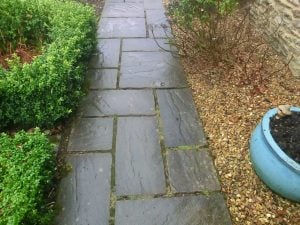Plant pots, containers, planters – 7 common questions answered
Plant pots, containers, planters - there’s an enormous choice out there. How do you choose what’s best for your plants and best for your garden? We answer seven of the most common questions.
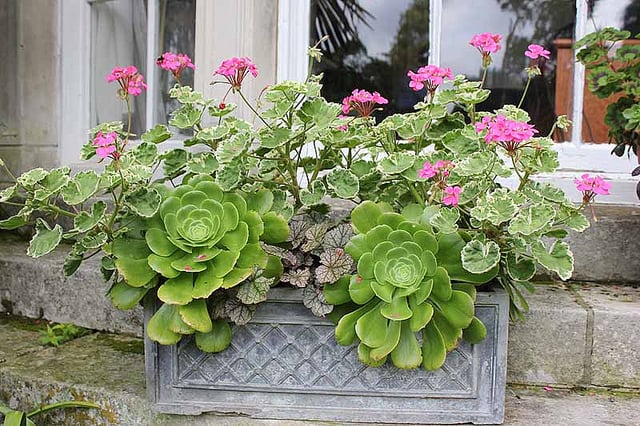
Tender planting of pelargoniums and Aeonium in trough at Myddelton House Gardens. © Rictor Norton & David Allen and reused under https://creativecommons.org/licenses/by/2.0/
1. What should I think about when choosing a pot?
As well as how good the pot looks, think about:
- how big the plant will grow
- how deep its roots will grow
- how large and heavy the foliage and flowers will be – the pot shouldn’t topple over
- adequate drainage holes
- whether the pot has to be frost-proof
- its weight – will you be able to move it once it’s full of compost?
2. What exactly is a container?
Let’s get this confusion cleared up straightaway. People use ‘container’ to mean two things:
- Something that probably doesn’t have drainage holes and that can contain a plant pot. It is sometimes called a jardinière. The beauty of this container is that you can change your plants with the seasons by replacing the pot within it.
- Anything you can grow a plant in, so it will have drainage holes. If not, you can drill or knock them through. They come in a variety of materials including four colours of rattan.
A ‘planter’ is the same thing.
3. Are plastic or terracotta plant pots the best?
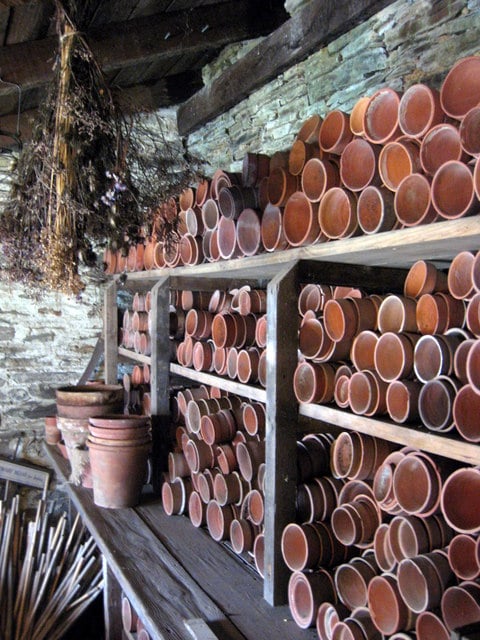
Interior of the potting shed in the Melon Garden, Heligan, Cornwall. The potting up of plants was a major task in such a large productive garden and the potting shed is laid out to enable this work to be carried out in a most efficient manner. © Rod Allday and re-used under Creative Commons Attribution-Share Alike 2.0 Generic licence.
Most plant pots bought are either clay/terracotta (both words are used for the same thing) or plastic.
Clay pots come unglazed (the red-brown colour) and glazed (almost any colour you like). Plastic pots come in an array of colours and can be made to look like terracotta. Which is the best depends on what you want to plant in it.
Terracotta pots fact file
- Heavier than plastic pots so have more stability but larger ones may be too heavy to move when full of damp soil and plants.
- Porous so air and water can pass through and roots can ‘breathe’. They dry out more quickly than plastic pots so are good for people with a tendency to overwater and for plants which thrive in dry conditions, such as Mediterranean herbs and cacti.
- Thick walls so plant roots are protected from rapid, potentially destructive changes in temperature.
- Can crack or break if frozen or dropped.
- Character-building tendency to flake in freezing weather, get crust of mineral salts from water and collect algae.
- Unglazed pots have a natural look and go with almost everything.
- Colourful glazed pots are less porous.
Plastic pots fact file
- Relatively cheap.
- Retain moisture well, needing less watering and providing a good environment for moisture-loving plants such as ferns and blueberries, or when germinating seeds.
- Plastic pots are lightweight, strong and flexible although sunlight can cause cheaper pots to fade and become brittle.
- Easier to clean than clay pots and do not weather.
- Thin walls provide little insulation from temperature change. Insulate with bubble wrap in winter to prevent plant roots from freezing. In summer, potting compost in black plastic pots can heat up quite quickly and damage roots.
4. Do seeds and seedlings need something special?
Seeds are sown in seed trays, small plant pots (7.5cm/3in) or cell modules, using a small amount of compost that stays fairly warm. After the seedlings have germinated and grown on a bit, transplant them a bit more deeply into a slightly bigger pot. This supports their stems, prevents leggy plants and helps them to develop plenty of fine fibrous roots.
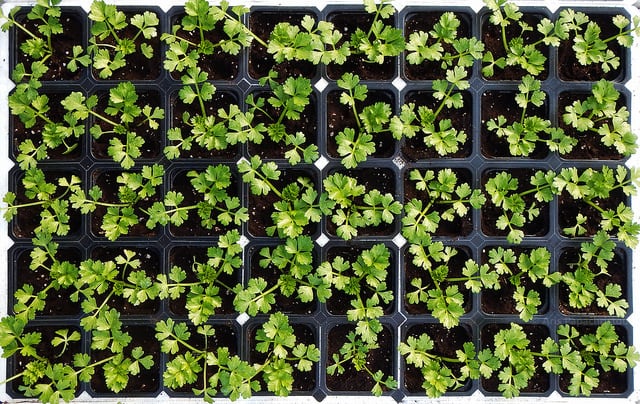
Celery seedlings in a module. © Aris Papachristou and reused under https://creativecommons.org/licenses/by/2.0/
5. What is a pan and what do you use it for?
Pans are wide and shallow plant pots. They are good for plants that are shallow-rooted such as wild strawberry, oregano and the different types of thyme. Their roots only go down about 10cm/4in and so don’t need much depth of potting compost. Many succulents also have shallow roots and look great in a succulent pan.
6. Who or what is Long Tom?
Long tom pots are tall and narrow and somehow rather elegant. The name seems somewhat mysterious but I suspect a connection through long tom chimney pots back to the Long Tom siege gun, a piece of artillery used in the Second Boer War, 1899-1902.
Long toms are good for plants that need depth or benefit from height: some herbs, some cacti, tulips, climbers which need a good root run. They are also traditionally used for topiary.
Herbs with long roots include basil, dill, tarragon, bay, sweet marjoram, lemongrass, lavender, rosemary and lemon balm.
Tulips like to be planted 20-30cms/8-12in deep. This keeps the bulbs cool which means they are more likely to flower year after year, and there’s no need to stake them.
7. What’s best for growing several plants together?
Anything which is big enough and deep enough to take them all.
- A tub is round, fairly squat and larger than most plant pots.
- A large square planter.
- A trough is long and shallow, and can help to make optimum use of space. They are great as window boxes, on top of walls or over the railings. Either grow plants directly in soil or potting compost or use troughs to house seasonal pots.
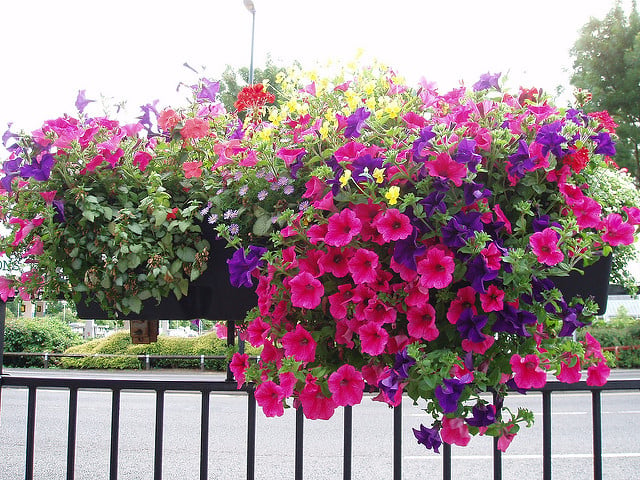
Colourful railing trough on Holyhead Road, Coventry, 16 July 2008. © Amanda Slater and reused under https://creativecommons.org/licenses/by-sa/2.0/
Sign up for our emails below, so we can send you blogs on gardening tips, as well as updates on our sales, so you don’t miss out on those garden furniture bargains!








